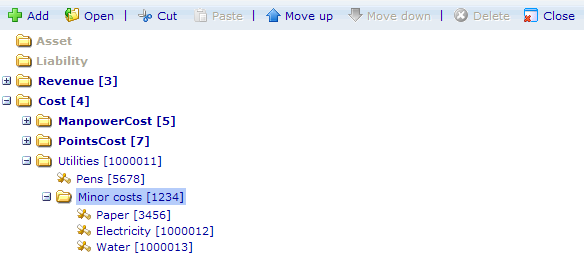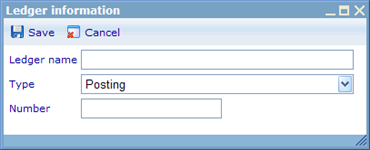Setting up the general ledger
More actions
Setting up the general ledger
Currently you can only build up an account structure under the Revenue and Cost main accounts. First time you see the account structure you will notice that there already exists a few accounts in these main accounts already. These preinserted accounts are called 'system accounts' and cannot be moved or deleted by users. All system accounts are identified by the account name being written in bold. You will also notice that the accounts have two different images related to them. The image looking like folders identify summary accounts whereas the paper roll identifies posting accounts.
A summary account is an account to which you cannot directly post entries (cost or revenue items). These accounts are used to summarise information from other summary accounts or from posting accounts. Summary accounts typically gather a number of similar accounts in it to get an idea of the cost or revenue amounts in a specific area.
A posting account is an account used for posting individual cost items. Each time a cost is incurred or revenue item received you must decide on which posting account to place this item in. Posting accounts cannot have other accounts in them.
The system accounts that exist are:
Manpower costs: This is a summary account. The only reason that this has been created as a system account is so that the 'System manpower cost' account could be placed in it.
System manpower costs: This is a posting account. The system automatically posts manpower cost using the information from user hourly cost and users registered and verified time on a resource (see time registration) to calculate how much the manpower used has cost the resource so far. It is possible to analyse these used man hours and costs in detail on the analyze time tab of any resource.
Points cost: This is a summary account. The only reason that this has been created as a system account is so that the 'System points cost' account could be placed in it.
System points cost: This is a posting account. This account will only be relevant when used for a questionnaire resource. The system automatically posts points given for filling in the answer sheets of the questionnaire to this account, since such points are seen as one of the costs of carrying out the questionnaire. The cost of each point is decided by the setting in the web config called ConversionRate.
Some of the general rules of setting up the general ledger are:
- You cannot delete accounts which have already had cost or revenue entries posted to them.
- You cannot place a posting account in another posting account.
- You cannot cut and paste cost accounts into revenue accounts and visa versa.
- You cannot give accounts the same name or number.
To start adding accounts to the structure, simply highlight the account under which you plan to place it and click the add button. Notice that there is also a right click menu with identical features as in the tools bar.
Build up an account structure that will make it easy for you to identify costs and revenues in accordance with which types you generally have on your projects. Should you have made mistakes it is possible to cut and paste these to new locations later. Make sure your accounts appear in the order in which you want them shown in the income statement. You can use the up and down arrows for this purpose.
The information that you can set for an account is a name, type (summary or posting) and an account number. Make sure that name and number are unique. Account numbers will automatically be shown in the account tree and income statements together with the ledger name, so you do not need to add the number as part of the name field.
Once you are satisfied with your account structure you can start placing entries in the posting accounts. You can read more about this in 'Adding cost and revenue entries'.


